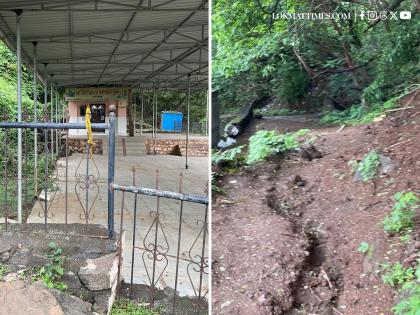Navi Mumbai: Environmentalists to Challenge CIDCO in Bombay HC Over Illegal Religious Structures on Belapur Hills
By Lokmat English Desk | Updated: July 4, 2025 16:43 IST2025-07-04T16:43:13+5:302025-07-04T16:43:59+5:30
A group of environmental activists is set to approach the Bombay High Court, accusing the City and Industrial Development ...

Navi Mumbai: Environmentalists to Challenge CIDCO in Bombay HC Over Illegal Religious Structures on Belapur Hills
A group of environmental activists is set to approach the Bombay High Court, accusing the City and Industrial Development Corporation (CIDCO) of failing to act against 30 illegal religious structures built on the vulnerable slopes of Belapur and Parsik Hills. Despite multiple judicial orders and directives from the Maharashtra State Human Rights Commission (MSHRC), CIDCO has not taken any concrete steps to demolish these potentially hazardous temples.Activist Krishnan Potti expressed strong disappointment, saying, “It is appalling that CIDCO has not acted, violating its own commitment made under oath to the MSHRC to demolish 29 structures on Belapur Hill and one on Parsik Hill.” Potti, along with other campaigners, is consulting legal counsel to file a writ petition in the High Court.
The environmentalists emphasize that their concern is not against religious beliefs or structures per se but centers on public safety. B N Kumar, director of the NatConnect Foundation, highlighted the growing danger posed by these temples, noting that the uprooting of hundreds of trees during construction has loosened the soil, making the hills prone to landslides. “Some temples have even begun expansions despite CIDCO’s notices,” Kumar added. Many of these structures can accommodate over a thousand devotees, putting numerous lives at risk. According to Supreme Court guidelines, illegal religious structures in public places must be categorized for demolition, regularization, or relocation. The temples on Belapur Hill fall under the demolition category, and notices have been served following a joint survey by CIDCO and the Navi Mumbai Municipal Corporation (NMMC). However, no action has been taken to date.
Local resident Kapil Kulkarni criticized CIDCO’s inaction, warning, “CIDCO officials are simply procrastinating. Will they act only after a tragedy like the Irshalwadi landslide, which claimed nearly 80 lives, occurs here?” The 2023 Irshalwadi landslide in Maharashtra’s Raigad district wiped out an entire village and serves as a grim reminder of the dangers posed by unstable hillsides.Several residential complexes have also been constructed on plots leased by CIDCO at the base of these hills, compounding the risk to human life and property.In August 2024, the MSHRC ordered CIDCO and NMMC to take action against these illegal structures after taking suo motu cognizance of media reports and NatConnect’s ongoing campaign to protect the hills.
CIDCO, however, has shifted responsibility to the NMMC, citing Supreme Court mandates for municipal bodies to act. Conversely, NMMC contends that the hills fall under CIDCO’s jurisdiction, a position supported by the Forest Department. Frustrated by the stalemate, NatConnect sought updates under the Right To Information (RTI) Act. The Urban Development Department (UDD), through State Information Officer Lakshmikant Jadhav, confirmed that reminders have been sent to CIDCO’s Managing Director and the NMMC Commissioner to comply with the Human Rights Commission’s directives. Activist and advocate Himanshu Katkar noted, “We have even lodged complaints with CIDCO’s chief vigilance officer, Suresh Mengade, who has only promised to look into the matter.” The activists vow to escalate the issue to the High Court as their last resort. As the monsoon season continues, the risk of landslides looms large, leaving residents, environmentalists, and authorities anxious for decisive action to safeguard lives and preserve the fragile ecosystem of Belapur and Parsik Hills.
Open in app